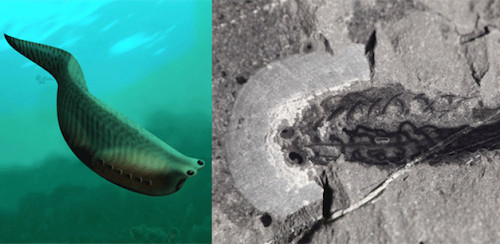 Evolution
Evolution
 Intelligent Design
Intelligent Design
Metaspriggina Revisited: Darwin Defender Strains at a Rabbit but Swallows a Camel

With apparent relish, PZ Myers poked fun at our statement about finding a vertebrate fish in the lower Cambrian: "for Darwinists, it should hardly be more surprising to find than a Precambrian rabbit." He thinks we said that Metaspriggina is "the equivalent of a Precambrian rabbit." Following that, he reproduced artist’s reconstructions of the Cambrian fish and two other Cambrian swimmers, followed by a photo of a living rabbit:
Which one would surprise you, boys and girls, if it were found swimming in the shallow, silty seas beneath the relatively hypoxic skies of planet Earth, 500 million years ago? Which ones look similar, as if they are related, yet don’t look like any modern organisms? (Emphasis added.)
Those silly Discovery Institute folks! "They don’t mount expeditions, they just sit around, read scientific papers, and misinterpret them."
Maybe a refresher course in English grammar would help the "happy atheist" Myers.
Does "hardly more surprising" have the same meaning as "the equivalent of"? Not by a long shot. A grenade can be just as surprising as a cluster bomb when you weren’t expecting any explosion at all. Did we ever say that Metaspriggina was found in the Precambrian? No; we consistently stated, as Conway Morris did in Nature, that it was found in the "lower Cambrian." Again, it would "hardly be more surprising to find" a vertebrate fish there than to find a Precambrian rabbit. Why? Because the gap between the most advanced Precambrian multicellular organism and a vertebrate fish is huge.
We listed some of the advanced features found in Metaspriggina, as given in the paper: "a notochord, a pair of prominent camera-type eyes, paired nasal sacs, possible cranium and arcualia, W-shaped myomeres, and a post-anal tail." Each one of these traits would have required the innovation of new cell types, tissue types, and body systems.
Think of just the "camera-type eyes" with binocular vision. They require a lens, a retina, light-sensitive molecules that can trigger nerves, and a brain to process the images. But even all those would be useless without the muscular system of myomeres able to respond via nerves in the notochord, so that the fish could quickly dart one way or the other. These systems all must be integrated to be useful.
Just to rub it in, let’s point out some of the other complex systems seen in this fish, as shown in Figure 1 in the paper in Nature: gill bars, possible extra-branchial cartilage, blood vessels, esophagus, gut, possible heart, and liver. In other words, this "basal vertebrate" had a central nervous system, a digestive system, a circulatory system, an excretory system, a muscular system, a locomotor system, a visual system, an olfactory system, and the ability to use all these systems in an integrated way.
For Myers to show an artist rendering of Pikaia (middle Cambrian) does not help his case. The Nature paper shows that Metaspriggina had the leap on it, earlier on: "The myomeres, totalling at least 40, are considerably more acute than in Pikaia and, in contrast to this chordate, Metaspriggina was evidently an effective swimmer." Thank you, PZ, for this illustration of evolution in reverse.
Rabbits, granted, have many additional traits, but they share the core vertebrate traits seen in Metaspriggina: a notochord, camera-type binocular eyes, paired nasal sacs, a cranium, muscles, a post-anal tail, and the integrated systems to use them: nervous, sensory, muscular, skeletal, digestive, et al.
A rabbit’s extra parts are elaborations on a body plan that Metaspriggina shows was already established in the lower Cambrian. Finding a vertebrate fish there, with all these systems fully operational (and no transitional forms leading up to them), presents an insurmountable hurdle to neo-Darwinism or any other unguided mechanism. To demand a Precambrian rabbit would only be to quibble about the height of the hurdle (would you prefer one mile, or two?).
The core question Stephen Meyer addresses in Darwin’s Doubt is this: How could a mindless, unguided natural process come up with the genetic information for some twenty complex body plans of the Cambrian animals? We only know of one cause capable of generating hierarchical, interrelated systems like those we observe in the Cambrian fossil record. Guess what that is?
